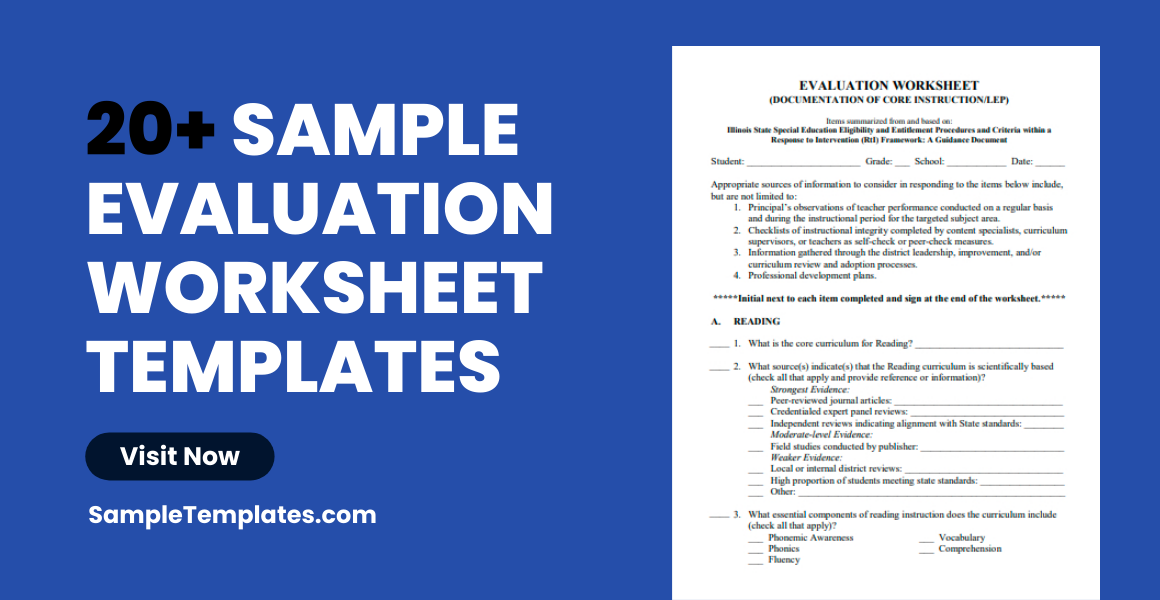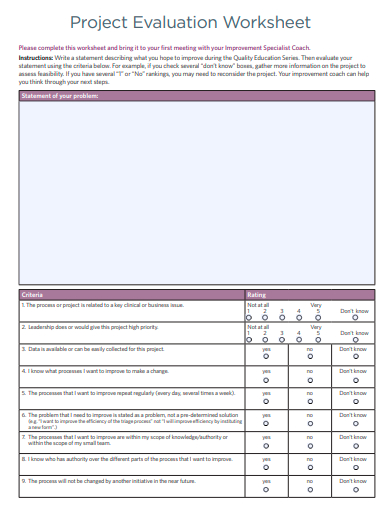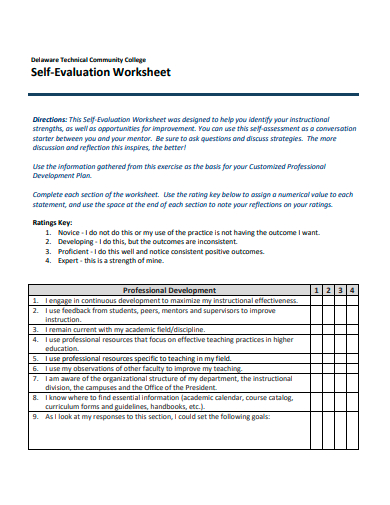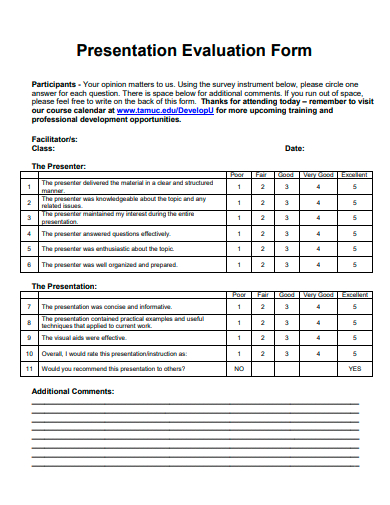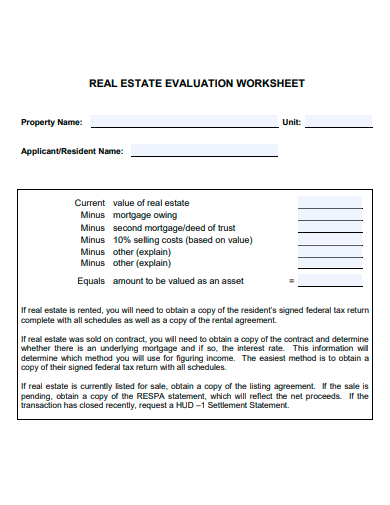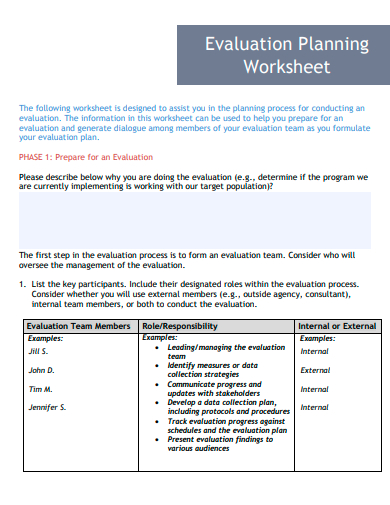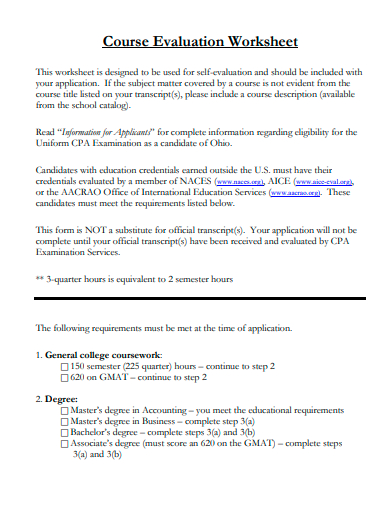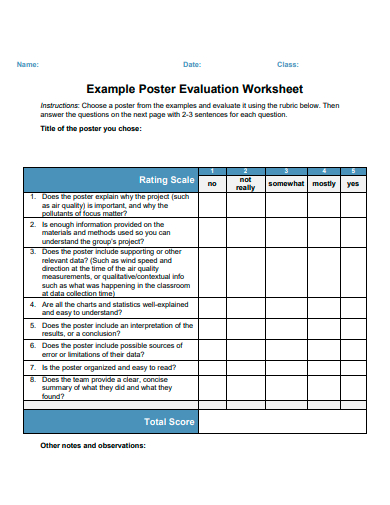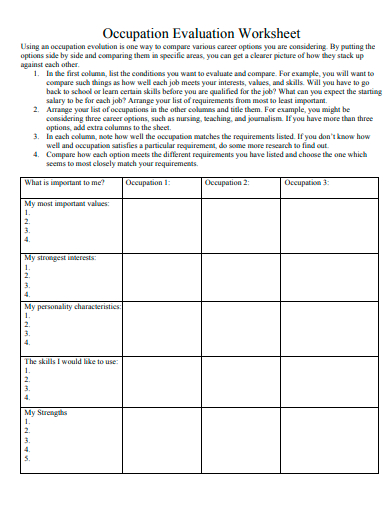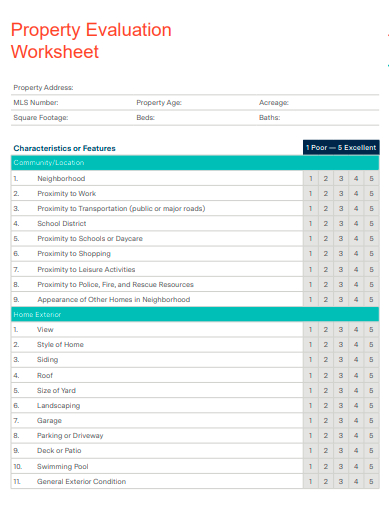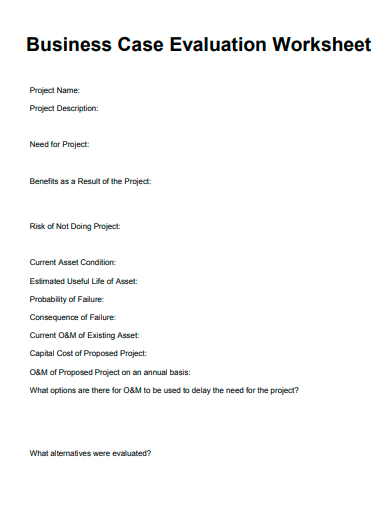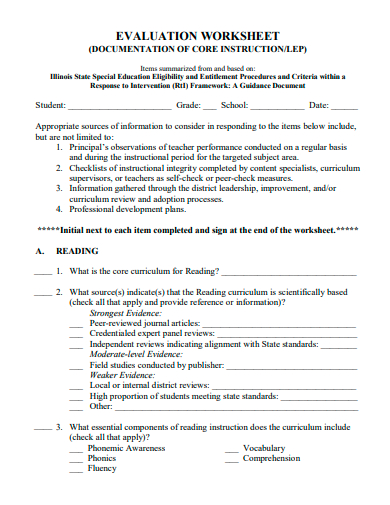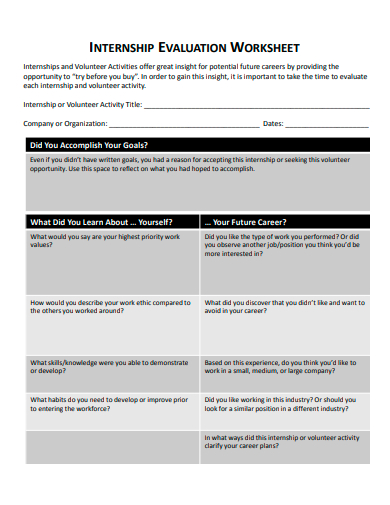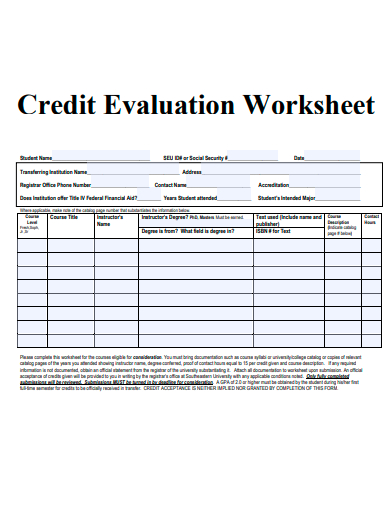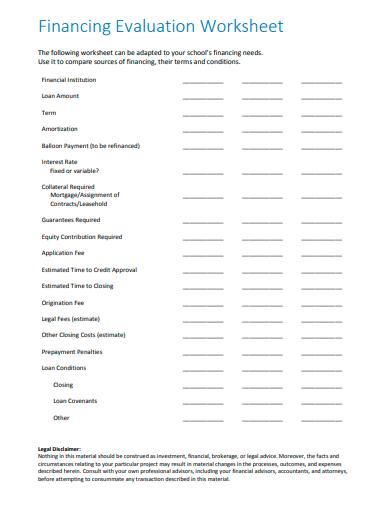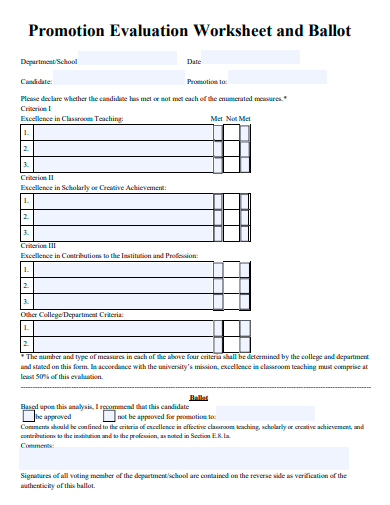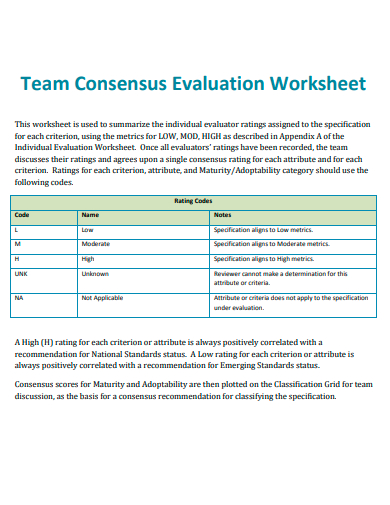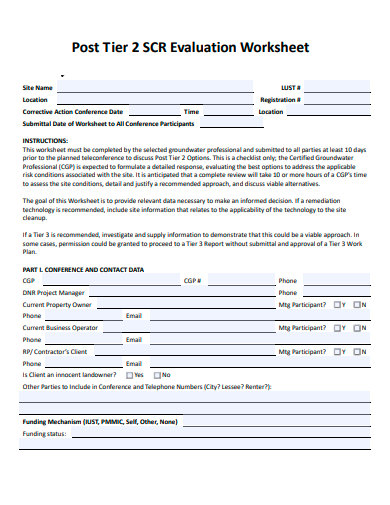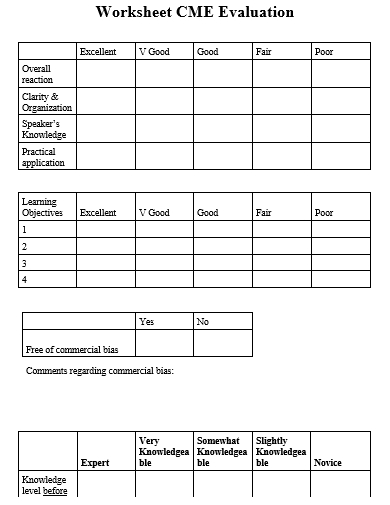Dive into our Sample Evaluation Worksheet Template—a tool designed for precision, clarity, and ease of use. Whether you’re assessing projects, personnel, or performances, our worksheet simplifies the process, ensuring comprehensive insights every time. Crafted for professionals who prioritize accuracy and efficiency, this template is a must-have. Make data-driven decisions, identify areas of improvement, and achieve your objectives seamlessly. Explore the gold standard in evaluation today.
20+ Evaluation Worksheet Samples
1. Project Evaluation Worksheet Template
2. Sample Offer Evaluation Worksheet Template
3. Self-Evaluation Worksheet Template
4. Sample Presentation Evaluation Form Template
5. Real Estate Evaluation Worksheet Template
6. Sample Evaluation Planning Worksheet Template
7. Course Evaluation Worksheet Template
Evaluation Worksheet: A Comprehensive Overview
An evaluation worksheet is a tool used by professionals, educators, and organizations to assess and analyze specific data, tasks, or performance. The core objective of this worksheet is to simplify the evaluation process, making it more systematic, organized, and efficient. Whether it’s for academic grading, project assessment, or performance review, an evaluation worksheet streamlines the procedure, ensuring that nothing is overlooked.
Structure and Components:
Typically, an evaluation worksheet is structured to capture key information. Common elements include:
Criteria for Evaluation: These are the standards or benchmarks against which the subject is being assessed. For instance, in an academic setting, criteria might involve understanding of a topic, presentation, originality, and more.
Rating Scale: Depending on the nature of the evaluation, this could be numerical (1-5), descriptive (Poor to Excellent), or even binary (Yes/No). The scale offers a quantifiable way to measure performance or quality against each criterion.
Comments Section: This area provides space for qualitative feedback, allowing evaluators to provide constructive criticism, suggestions, or notes on specific areas.
Benefits of Using an Evaluation Worksheet:
Consistency: With a standardized format, it ensures that every aspect or individual is evaluated on the same criteria, minimizing bias and ensuring fairness.
Comprehensiveness: Because worksheets are typically designed with a thorough approach in mind, they guarantee that every relevant facet is considered during the evaluation process.
Efficiency: By having a clear structure, the evaluation process becomes faster, enabling evaluators to process more assessments in less time.
Record Keeping: They serve as a record of the assessment, which can be useful for future references, comparisons, or audits.
Versatility of Application:
The beauty of evaluation worksheets is their wide range of applications. They can be used in:
Educational Settings: Teachers and instructors utilize them to grade student performances, projects, or even participation.
Business Environments: Managers and HR professionals may employ them for employee appraisals, project evaluations, or vendor assessments.
Healthcare: Medical professionals might use them to assess patient progress, treatment efficacy, or even in peer reviews.
Customization:
While many generic evaluation worksheets are available, one of the most advantageous aspects is the ability to customize them. Depending on the specific needs and criteria of an organization or individual, these worksheets can be tailored to capture the most relevant data, ensuring that the evaluation is both meaningful and actionable.
In a world driven by data and continuous improvement, evaluation worksheets have become indispensable. They not only provide a systematic method for assessment but also ensure that evaluations are fair, consistent, and detailed. Whether you’re an educator looking to grade assignments, a manager assessing project success, or a healthcare professional monitoring treatment outcomes, these worksheets are invaluable tools that facilitate informed decision-making and continuous growth.
8. Sample Proposal Evaluation Worksheet Template
9. Poster Evaluation Worksheet Template
10. Occupation Evaluation Worksheet Template
11. Sample Property Evaluation Worksheet Template
12. Business Case Evaluation Worksheet Template
13. Sample Evaluation Worksheet Template
14. Internship Evaluation Worksheet Template
Creating an Evaluation Sheet: A Step-by-Step Guide
Creating an evaluation sheet is an essential task for many professionals, educators, and organizations. A well-structured evaluation sheet ensures that assessments are consistent, fair, and comprehensive. Here’s a step-by-step guide to creating an effective evaluation sheet:
Define the Purpose:
Before diving into the design, understand the objective of your evaluation sheet. Are you grading student assignments, assessing employee performance, or gauging the success of a project? Your purpose will guide the content and structure of your sheet.
Identify Key Criteria:
List down all the criteria you want to evaluate. These could range from specific skills, knowledge areas, performance metrics, or any other relevant parameters. It’s essential to be clear and specific with each criterion to avoid any ambiguity during the assessment.
Decide on a Rating Scale:
Choose a rating system that aligns with your evaluation needs. Common scales include:
Numerical Scale (e.g., 1-5)
Descriptive Scale (e.g., Poor to Excellent)
Binary Scale (e.g., Yes/No or Pass/Fail)
The complexity of your evaluation and the depth of feedback you wish to provide will determine the best scale.
Design the Layout:
Start with a clear title that defines the purpose of the sheet. Then:
Arrange criteria: You can list them in a tabular format or bullet points, depending on the number of criteria and the complexity of the evaluation.
Provide space for ratings: Next to each criterion, allocate space for the evaluator to mark the rating.
Include a comments section: Allow space for evaluators to provide qualitative feedback or elaborate on their ratings.
Add Instructions:
At the beginning or end of the evaluation sheet, include clear instructions on how to fill it out. This might cover how to use the rating scale, any time limits, or guidelines on providing feedback.
Pilot Test:
Before fully adopting your evaluation sheet, test it with a small group. This allows you to identify any potential issues or areas of confusion. Gather feedback and make necessary adjustments.
Incorporate Flexibility:
It’s essential to recognize that no evaluation process is static. As objectives evolve or new information emerges, your evaluation sheet might need tweaks. Design it in a way that makes it easy to adapt or modify in the future.
Digital vs. Physical:
Decide whether you want a digital evaluation sheet or a physical one. Digital sheets (like those created in spreadsheet programs or specialized software) offer advantages like automatic calculations, easy modifications, and electronic storage. Physical sheets, on the other hand, might be more accessible in settings without tech infrastructure.
Creating an evaluation sheet is more than just listing criteria and assigning ratings. It’s about ensuring that the assessment process is as efficient, fair, and meaningful as possible. By following these steps and continuously refining the process based on feedback and changing needs, you can ensure that your evaluation sheet remains a valuable tool in your assessment arsenal.
15. Credit Evaluation Worksheet Template
16. Sample Summary Evaluation Worksheet Template
17. Financing Evaluation Worksheet Template
18. Promotion Evaluation Worksheet Template
19. Sample Team Evaluation Worksheet Template
20. Evaluation Worksheet Template
21. Evaluation Worksheet in DOC
What to Include in an Evaluation Worksheet: Essential Components
An evaluation worksheet serves as a systematic tool to measure and assess various parameters, depending on its purpose. Whether it’s for educational grading, employee performance review, or project assessment, a well-constructed worksheet ensures accuracy, fairness, and comprehensive insights. Let’s delve into the crucial components to include in an evaluation worksheet:
Clear Header:
Begin with a distinct title that communicates the purpose of the evaluation. This could be “Employee Performance Review, Class Assignment Grading, or Project Assessment. Accompanying the title, include any relevant details like date, name, or department.
Objectives or Purpose:
Clarify the primary goals or reasons for the evaluation. For instance, if it’s a student assessment, the objective might be “To evaluate the student’s grasp on the subject matter and presentation skills.”
Criteria for Evaluation:
This is the backbone of your worksheet:
Specific Parameters: Break down the aspects or attributes you’ll be assessing. For a project evaluation, this might include parameters like ‘timeliness,’ ‘budget adherence,’ and ‘quality of output.’
Descriptors: Beneath or beside each criterion, provide descriptors that explain what is expected. For instance, under ‘timeliness,’ you could specify “Was the project completed by the stipulated deadline?”
Rating System:
Establish a consistent method to quantify or qualify the assessment:
Scale: Decide on a numerical (1-5), descriptive (Poor to Excellent), or binary (Yes/No) scale.
Definitions: Provide clarity on what each rating means. If using a numerical scale, describe what constitutes a ‘1’ versus a ‘5.’
Comments and Feedback Section:
Allocate space where evaluators can jot down qualitative insights, suggestions for improvement, or other relevant notes. This section provides context to the ratings and can be invaluable for the recipient’s growth and understanding.
Summary or Overall Assessment:
Depending on the complexity of your evaluation, you might include a section where evaluators can provide an overall rating or summarize their findings. This gives a holistic view of the evaluation, beyond individual criteria.
Recommendations or Action Steps:
Especially in settings like performance reviews or project assessments, it’s helpful to have a section dedicated to suggested actions based on the evaluation. This could include training recommendations, areas for further study, or next steps in a project lifecycle.
Evaluator’s Details:
Include a space for the evaluator’s name, designation, and date of assessment. This ensures accountability and clarity about who conducted the assessment.
Recipient’s Acknowledgment:
For worksheets like performance reviews, having a space where the person being evaluated acknowledges receipt and understanding can be important. This might also include a section for their comments or rebuttals.
Flexibility for Additional Notes:
Leave some room or an “additional notes” section for any unforeseen comments or points the evaluator might want to add, which don’t fit neatly into predefined categories.
An evaluation worksheet, when thoughtfully constructed, can be an indispensable tool for systematic and objective assessments. Including the above components ensures that evaluations are thorough, transparent, and actionable, benefiting both evaluators and recipients. As you design your worksheet, always keep the end goal in mind: to facilitate understanding, growth, and improvement.
Related Posts
FREE 20+ Goal Setting Worksheet Samples in MS Word | Google Docs | Pages | Excel | Google Sheets | Numbers | PPT | PDF
FREE 30+ Cost Worksheet Samples in Google Docs | Google Sheets | MS Excel | MS Word | Apple Numbers | Apple Pages | PDF
FREE 50+ Assessment Worksheet Samples in PDF | MS Word
FREE 25+ Campaign Worksheet Samples in PDF
FREE 50+ Application Worksheet Samples in PDF | MS Word
FREE 10+ Distribution Worksheet Samples in PDF
FREE 10+ Family Worksheet Samples in PDF
FREE 10+ Personal Worksheet Samples in PDF
FREE 7+ Depreciation Worksheet Samples & Templates in PDF | MS Word
FREE 10+ Typing Worksheets Samples in PDF | DOC
FREE 10+ Maths Worksheets Samples in PDF | DOC
FREE 10+ 4th grade Worksheets Samples in PDF
FREE 10+ Weekly Budget Worksheet Samples in MS Word | MS Excel | Google Docs | Google Sheets | PDF
FREE 10+ Expense Worksheet Samples in PDF
FREE 10+ Investment Worksheet Samples in PDF
